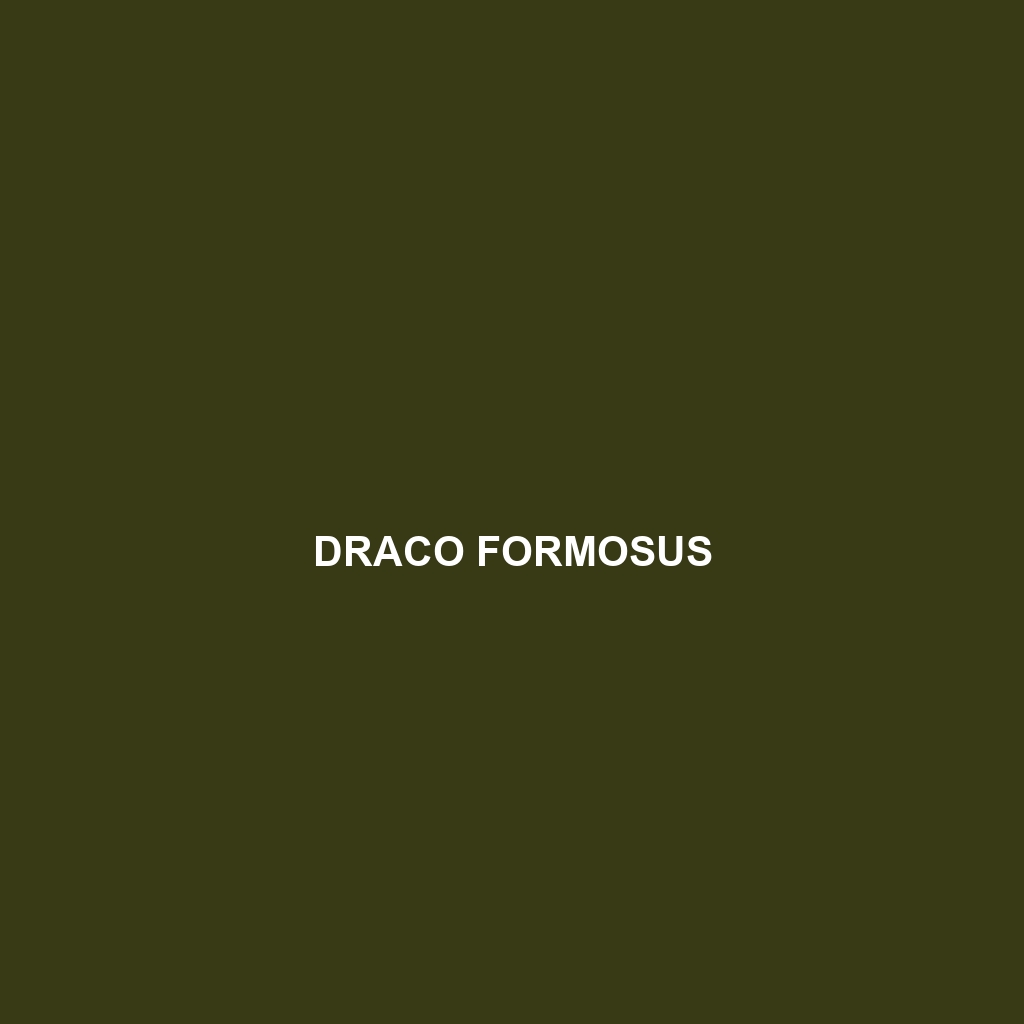Common Name
Draco formosus
Scientific Name
Draco formosus
Habitat
Draco formosus, commonly known as the Flying Dragon, is primarily found in the lush rainforests of Southeast Asia, particularly in countries such as Indonesia, Malaysia, and the Philippines. This remarkable species thrives in humid tropical environments where temperatures typically range between 20°C and 30°C. The Flying Dragon can often be spotted gliding between trees in the dense canopy, taking advantage of the ample vegetation and abundant sunlight. These creatures prefer the upper levels of the forest, which provide both safety from ground predators and access to their primary food sources. The presence of mature trees with suitable foliage is crucial for their survival, making the health of these rainforest ecosystems essential for the conservation of Draco formosus.
Physical Characteristics
Draco formosus exhibits several unique physical traits that set it apart from other species within the Draco genus. Adults typically measure between 20 to 30 centimeters in length, including a lightweight and elongated body. Their most distinctive feature is the wing-like rib extensions covered in colorful skin flaps, which can reach up to 12 cm and allow them to glide gracefully between trees. The dorsal side of Draco formosus is usually a vivid green or brown, which aids in camouflage against predators, while the ventral side boasts a paler hue. This coloration not only serves as an adaptive advantage but also enhances their aesthetic appeal, making them a favored subject for wildlife photography. Another fascinating trait is their throat flap, or ‘dewlap,’ which they can expand significantly during mating displays to attract potential mates.
Behavior
Behaviorally, Draco formosus is known for its exceptional gliding ability, a characteristic that helps them navigate their arboreal habitat efficiently. They can glide distances of up to 10 meters using their extended rib flaps to catch the wind. Their social structures are generally solitary, though they may exhibit brief interactions during the mating season. Draco formosus tends to be diurnal, being most active during daylight hours as they forage for food. These lizards employ a unique method of communication, characterized by subtle body movements and visual displays involving their dewlap, particularly during mating rituals. Their nocturnal habits are limited to being alert against potential predators, utilizing their camouflage to remain unseen.
Diet
The dietary habits of Draco formosus are predominantly insectivorous, feeding primarily on ants, beetles, and other small arthropods. Their diet is supplemented with soft leaves and fruits, highlighting their adaptability as omnivores. With elongated, sticky tongues, they are highly skilled at catching insects mid-air or foraging from tree bark and foliage. Their feeding patterns are influenced by the availability of food sources, often causing them to shift their territory in search of sustenance. This dietary flexibility plays a critical role in maintaining the balance within their rainforest ecosystem.
Reproduction
The reproductive cycle of Draco formosus is marked by unique behaviors and reproductive strategies. Mating typically occurs during the rainy season, which provides an abundance of resources for the offspring. After a gestation period of approximately 30 to 40 days, females lay 2 to 4 eggs, which are often hidden within the crevices of tree bark to protect them from predators. The eggs hatch after an incubation period of around 50 to 60 days. Upon hatching, the young are independently capable of gliding, showcasing their skills immediately after emergence. Parental care is limited, with the young taking on the responsibility of foraging and self-defense soon after they hatch.
Conservation Status
The conservation status of Draco formosus is currently classified as Least Concern by the International Union for Conservation of Nature (IUCN). However, this species faces threats from habitat destruction due to deforestation for agriculture and urban development. Conservation efforts are being made to protect their rainforest habitats, including establishing protected areas and promoting sustainable land use practices. Continuous monitoring and research are vital to ensure the survival of Draco formosus in the wild, especially in regions experiencing rapid ecological changes.
Interesting Facts
One of the most fascinating aspects of Draco formosus is its ability to control its gliding trajectory by altering its body orientation and wing extensions. Additionally, these reptiles possess a unique defense mechanism: when threatened, they can flatten their bodies and remain motionless against tree bark, effectively blending into their surroundings. This remarkable adaptation not only aids in evading predators but also highlights the evolutionary ingenuity of these lizards. Furthermore, their vibrant colors serve not just as camouflage but also play a vital role in social interactions, signaling health and vitality to potential mates.
Role in Ecosystem
Draco formosus holds a critical role in maintaining the health of its rainforest ecosystem. As a pest control agent, their dietary habits help regulate insect populations, contributing to ecological balance. Additionally, their feeding on flowers and fruits aids in pollination and seed dispersal, influencing the growth of various plant species. By occupying a unique niche in their habitat, these lizards contribute to the overall biodiversity and stability of the rainforest ecosystem. Understanding the ecological roles of species like Draco formosus is essential for fostering appreciation for wildlife conservation and the intricate connections between organisms in nature.
